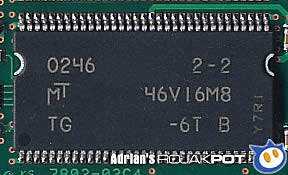The Chip

Naturally, the DDR SDRAM chips used in this DIMM were manufactured by Micron themselves. On the right is a shot of one of the DIMM's sixteen DDR SDRAM chips.
It's a 128 Mbit chip with an access time of 6.0ns. That means that it's designed to run at 166MHz. Now wait a minute. Isn't this chip supposed to run at 333MHz?
Well, technically no. You see, the chips still run at 166MHz but they were internally widened to deliver a single 2n-bits wide (where n is a number) data transfer per clock cycle. This is different from standard SDRAM which only deliver one n-bit wide data transfers per clock cycle.
At the I/O pins however, the single 2n-bit wide data transfer is split into two n-bit wide, half clock cycle data transfers. The two pieces of data are then transferred to the memory controller on both the rising and falling edges of the signal. This differs from normal SDRAM which only carries data on the rising edge of the signal.
In short, the internal DRAM core has been redesigned to allow twice as much data to reach the I/O pins in a single clock cycle. The data is then split up so that half of it is transmitted via the rising edge of the signal while the other half is carried by the falling edge of the signal.
It's probably because twice as much data is being transferred per clock cycle which is why manufacturers and end-users alike continue to label 166MHz DDR SDRAM as 333MHz DDR SDRAM. It's like saying that AGP2X actually runs at 133MHz, which it does not. Neither the memory chips nor the interface run at 333MHz. They are just twice as fast because they do twice as much work in a single clock cycle. But irrespective of what they call it, DDR SDRAM is definitely twice as fast as normal SDRAM.
However, to avoid confusing everyone, I will continue to use the misnomer of
333MHz to describe the speed of this DDR SDRAM DIMM. Now, let's take a look
at this memory chip's specifications :-
|
Chip Capacity
|
128 Mbit
|
|
Configuration
|
4M x 8 x 4 banks
|
|
SDRAM Speed Grade
|
6.0 ns
|
|
Actual Memory Clock
|
167 MHz
|
|
Data Transfers Per Clock
|
2
|
|
Maximum Transfer Rate
|
2.7 GB/s
|
|
Latency
|
2.5 - 3 - 3
|
|
Allowable Clock Speeds @
CL2
|
75 - 133 MHz
|
|
Allowable Clock Speed @ CL2.5
|
75 - 167 MHz
|
|
Average Refresh Rate
|
15.6 µs
|
|
I/O Voltage
|
2.3 - 2.7 V
|
|
Operating Temperature
|
0 to 70 °C
|
|
Power Dissipation
|
1 W
|
Enough with the details. Now, let's see how well this DDR SDRAM DIMM works







 Add to Reddit
Add to Reddit
